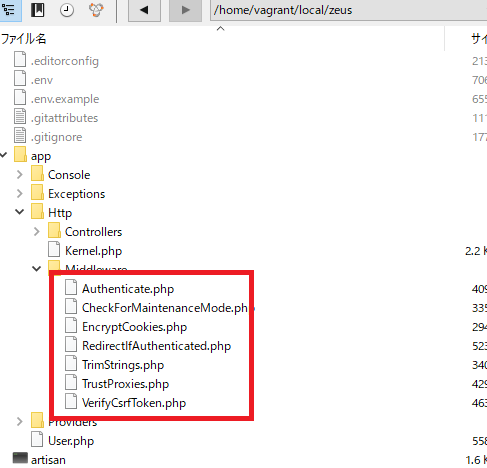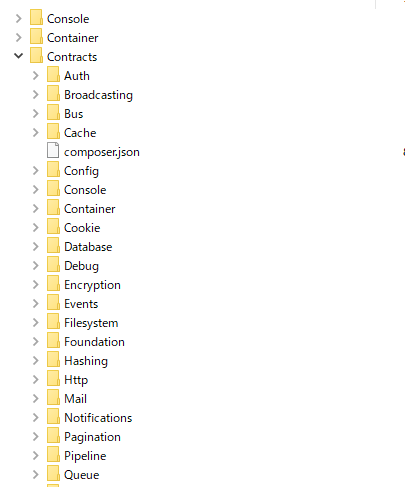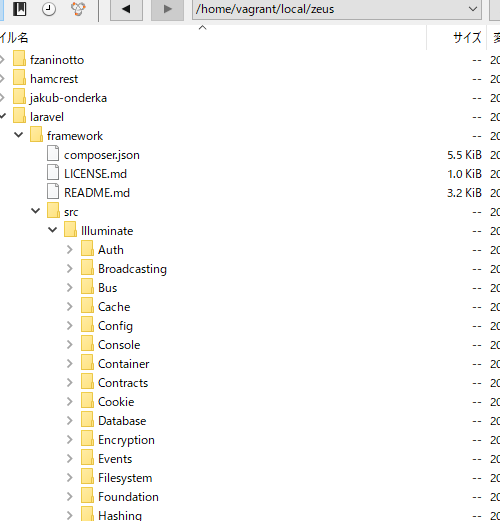Whether a middleware runs before or after a request depends on the middleware itself. For example, the following middleware would perform some task before the request is handled by the application:
namespace App\Http\Middleware;
use Closure;
class BeforeMiddleware
{
public function handle($request, Closure $next)
{
// Perform action
return $next($request);
}
}
handleの関数でClosere $nextを渡しています。returnは$nextだけでよくわかりません。
However, this middleware would perform its task after the request is handled by the application:
namespace App\Http\Middleware;
use Closure;
class AfterMiddleware
{
public function handle($request, Closure $next)
{
$response = $next($request);
// Perform action
return $response;
}
}
冗長に書いてます。
Registering Middleware
Global Middleware
If you want a middleware to run during every HTTP request to your application, list the middleware class in the $middleware property of your app/Http/Kernel.php class.
どういうことだ。
Assigning Middleware To Routes
If you would like to assign middleware to specific routes, you should first assign the middleware a key in your app/Http/Kernel.php file. By default, the $routeMiddleware property of this class contains entries for the middleware included with Laravel. To add your own, append it to this list and assign it a key of your choosing:
middlewareを編集する際にはkernel.phpを見ろと。
namespace App\Http;
use Illuminate\Foundation\Http\Kernel as HttpKernel;
class Kernel extends HttpKernel
{
/**
* The application's global HTTP middleware stack.
*
* These middleware are run during every request to your application.
*
* @var array
*/
protected $middleware = [
\App\Http\Middleware\CheckForMaintenanceMode::class,
\Illuminate\Foundation\Http\Middleware\ValidatePostSize::class,
\App\Http\Middleware\TrimStrings::class,
\Illuminate\Foundation\Http\Middleware\ConvertEmptyStringsToNull::class,
\App\Http\Middleware\TrustProxies::class,
];
/**
* The application's route middleware groups.
*
* @var array
*/
protected $middlewareGroups = [
'web' => [
\App\Http\Middleware\EncryptCookies::class,
\Illuminate\Cookie\Middleware\AddQueuedCookiesToResponse::class,
\Illuminate\Session\Middleware\StartSession::class,
// \Illuminate\Session\Middleware\AuthenticateSession::class,
\Illuminate\View\Middleware\ShareErrorsFromSession::class,
\App\Http\Middleware\VerifyCsrfToken::class,
\Illuminate\Routing\Middleware\SubstituteBindings::class,
],
'api' => [
'throttle:60,1',
'bindings',
],
];
/**
* The application's route middleware.
*
* These middleware may be assigned to groups or used individually.
*
* @var array
*/
protected $routeMiddleware = [
'auth' => \App\Http\Middleware\Authenticate::class,
'auth.basic' => \Illuminate\Auth\Middleware\AuthenticateWithBasicAuth::class,
'bindings' => \Illuminate\Routing\Middleware\SubstituteBindings::class,
'cache.headers' => \Illuminate\Http\Middleware\SetCacheHeaders::class,
'can' => \Illuminate\Auth\Middleware\Authorize::class,
'guest' => \App\Http\Middleware\RedirectIfAuthenticated::class,
'signed' => \Illuminate\Routing\Middleware\ValidateSignature::class,
'throttle' => \Illuminate\Routing\Middleware\ThrottleRequests::class,
'verified' => \Illuminate\Auth\Middleware\EnsureEmailIsVerified::class,
];
}
ホントだ、書かれている内容が違う。
auth, auth.basic, binding, cache.headers, can, guest, signed, throttle, verified
canってなんだ? えらいシンプルだが。
Once the middleware has been defined in the HTTP kernel, you may use the middleware method to assign middleware to a route:
Route::get('admin/profile', function () {
//
})->middleware('auth');
あー、kernelで定義すると、routingなどで使えるようになる。なるほど。
Route::get('/', function () {
//
})->middleware('first', 'second');
When assigning middleware, you may also pass the fully qualified class name:
classのパスを書けば、使えるようになる。この辺はjavaなどと一緒ですな。
use App\Http\Middleware\CheckAge;
Route::get('admin/profile', function () {
//
})->middleware(CheckAge::class);
Middleware Groups
Sometimes you may want to group several middleware under a single key to make them easier to assign to routes. You may do this using the $middlewareGroups property of your HTTP kernel.
Out of the box, Laravel comes with web and api middleware groups that contain common middleware you may want to apply to your web UI and API routes:
protected $middlewareGroups = [
'web' => [
\App\Http\Middleware\EncryptCookies::class,
\Illuminate\Cookie\Middleware\AddQueuedCookiesToResponse::class,
\Illuminate\Session\Middleware\StartSession::class,
\Illuminate\View\Middleware\ShareErrorsFromSession::class,
\App\Http\Middleware\VerifyCsrfToken::class,
\Illuminate\Routing\Middleware\SubstituteBindings::class,
],
'api' => [
'throttle:60,1',
'auth:api',
],
];
あれ、これはkernel.phpか。
Middleware groups may be assigned to routes and controller actions using the same syntax as individual middleware. Again, middleware groups make it more convenient to assign many middleware to a route at once:
Route::get('/', function () {
//
})->middleware('web');
Route::group(['middleware' => ['web']], function () {
//
});
Middleware Parameters
Middleware can also receive additional parameters. For example, if your application needs to verify that the authenticated user has a given “role” before performing a given action, you could create a CheckRole middleware that receives a role name as an additional argument.
Additional middleware parameters will be passed to the middleware after the $next argument:
大体パラメーターは使えますな。
namespace App\Http\Middleware;
use Closure;
class CheckRole
{
/**
* Handle the incoming request.
*
* @param \Illuminate\Http\Request $request
* @param \Closure $next
* @param string $role
* @return mixed
*/
public function handle($request, Closure $next, $role)
{
if (! $request->user()->hasRole($role)) {
// Redirect...
}
return $next($request);
}
}
Middleware parameters may be specified when defining the route by separating the middleware name and parameters with a :. Multiple parameters should be delimited by commas:
Route::put('post/{id}', function ($id) {
//
})->middleware('role:editor');
Terminable Middleware
Sometimes a middleware may need to do some work after the HTTP response has been prepared. For example, the “session” middleware included with Laravel writes the session data to storage after the response has been fully prepared. If you define a terminate method on your middleware, it will automatically be called after the response is ready to be sent to the browser.
namespace Illuminate\Session\Middleware;
use Closure;
class StartSession
{
public function handle($request, Closure $next)
{
return $next($request);
}
public function terminate($request, $response)
{
// Store the session data...
}
}



